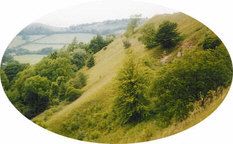 Eight hundred feet of the western Cotswold scarp drops steeply then gently, to the Severn Vale, hindered here and there by the outliers of Peaked Down, Cam Long Down and Smallpox Hill. From these limestone tops can be see the eastern edge of the Forest of Dean, and, on a good day, the distant Black Mountains, the Sugar Loaf, and the peaked summit of Pen-y-Fan in the South Wales massif. The estuary waters of the River Severn glint and shine, a remnant of turquoise seas that anciently lapped at the foot of this western edge. Where once were bays and inlets, there are now the secret combes of the western Cotswolds.
Eight hundred feet of the western Cotswold scarp drops steeply then gently, to the Severn Vale, hindered here and there by the outliers of Peaked Down, Cam Long Down and Smallpox Hill. From these limestone tops can be see the eastern edge of the Forest of Dean, and, on a good day, the distant Black Mountains, the Sugar Loaf, and the peaked summit of Pen-y-Fan in the South Wales massif. The estuary waters of the River Severn glint and shine, a remnant of turquoise seas that anciently lapped at the foot of this western edge. Where once were bays and inlets, there are now the secret combes of the western Cotswolds.
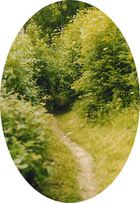 Walking is difficult on this steep scarp, away from the footpaths, but this is my 'hunting' ground. Here, in woods of Ash, Beech, Hazel and Sycamore, I search carefully, in all seasons, for heron, otter, owl, mole, hare, eel, swan, snake. Autumn is good, but any time of the year will do. I like May best, when the wild parsley fades into June, and these slopes develop their leafy under-storey of saplings, cloaking the deer runs which enable me to creep beneath this grey-green duvet of foliage. It's a secret world of chiming Bullfinches, the worried whining of nesting Chiff Chaffs, the harsh sneering of Jays. In the stillness of this luxuriant lower storey, mobs of Roe Deer strain to make sense of what I am, before their nerve breaks and they hurriedly make off through sunlit pools of ivy. You have to become a bit wild yourself here, wary and listening, under majestic Beeches ringing with the calls of Buzzards, and the chatter of Jackdaws.
Walking is difficult on this steep scarp, away from the footpaths, but this is my 'hunting' ground. Here, in woods of Ash, Beech, Hazel and Sycamore, I search carefully, in all seasons, for heron, otter, owl, mole, hare, eel, swan, snake. Autumn is good, but any time of the year will do. I like May best, when the wild parsley fades into June, and these slopes develop their leafy under-storey of saplings, cloaking the deer runs which enable me to creep beneath this grey-green duvet of foliage. It's a secret world of chiming Bullfinches, the worried whining of nesting Chiff Chaffs, the harsh sneering of Jays. In the stillness of this luxuriant lower storey, mobs of Roe Deer strain to make sense of what I am, before their nerve breaks and they hurriedly make off through sunlit pools of ivy. You have to become a bit wild yourself here, wary and listening, under majestic Beeches ringing with the calls of Buzzards, and the chatter of Jackdaws.
 Many have hunted here before me, for this western Cotswold edge has sheltered peoples since Palaeolithic times. They were lowland types and it was not until the Mesolithic's arrived from across the swamp we now call the North Sea, that these woods and forests were first settled. There were the 'forest folk' - the Maglemosians, with their flint axes; and people from settlements in Wales and Cornwall arriving, possibly, on the Severn itself, searching out new grazing for their livestock, on top of the scarp. The edge still has physical remnants of these ancients, and I like to think I'm following in their footsteps with my own tools for 'hunting'.
Many have hunted here before me, for this western Cotswold edge has sheltered peoples since Palaeolithic times. They were lowland types and it was not until the Mesolithic's arrived from across the swamp we now call the North Sea, that these woods and forests were first settled. There were the 'forest folk' - the Maglemosians, with their flint axes; and people from settlements in Wales and Cornwall arriving, possibly, on the Severn itself, searching out new grazing for their livestock, on top of the scarp. The edge still has physical remnants of these ancients, and I like to think I'm following in their footsteps with my own tools for 'hunting'.
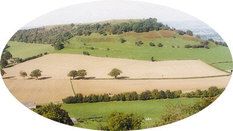 When an ash key sets on this scarp, it must first germinate and, as it grows, many seasons of leaf mould will accumulate over the seedling, forcing it to grow out, away from the slope, which lengthens its root growth, before the sapling then develops vertically. It is this root growth which determines what 'creature' I will take home, the form and amount determining what I can fashion from it. Thickness and straightness are key - not quite looking for a needle in a haystack, but two good sticks from a day's searching and I'm happy!
When an ash key sets on this scarp, it must first germinate and, as it grows, many seasons of leaf mould will accumulate over the seedling, forcing it to grow out, away from the slope, which lengthens its root growth, before the sapling then develops vertically. It is this root growth which determines what 'creature' I will take home, the form and amount determining what I can fashion from it. Thickness and straightness are key - not quite looking for a needle in a haystack, but two good sticks from a day's searching and I'm happy!
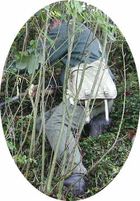 It is unusual for my sticks to be without a natural blemish or two - indeed, they can enhance the finished product. Most blemishes are caused by wandering Roe Deer biting at the bark as they pass, or Rabbits nibbling it closer to the ground. Natural twists and spirals are rare, caused by the growth of honeysuckle up the stem - but are real gems! The moment of truth comes when the leaf mould is removed from the root growth, revealing possibly more treasure
It is unusual for my sticks to be without a natural blemish or two - indeed, they can enhance the finished product. Most blemishes are caused by wandering Roe Deer biting at the bark as they pass, or Rabbits nibbling it closer to the ground. Natural twists and spirals are rare, caused by the growth of honeysuckle up the stem - but are real gems! The moment of truth comes when the leaf mould is removed from the root growth, revealing possibly more treasure
Abundant Ash is the wood I most often use for my 'Ramblersticks'. It is tight-grained, light in colour, seasons well and is good to carve, paint and varnish. I work the stick as soon as practically possible after cutting, removing the bark at the handle, and roughly shaping the raw wood. It is then left to season, but not to dry out, as the wood might die and be unusable. Native wild birds and animals are my preferred subjects.
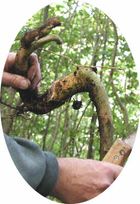 Each 'Ramblerstick' is hand carved, painted with artist's water-colours, before three coats of UV varnish is applied, after which it is detailed with crystal eyes and a ferrule of either rubber or brass. Give your 'Ramblerstick' a wipe after use, and store it carefully in cool, dry conditions.
Each 'Ramblerstick' is hand carved, painted with artist's water-colours, before three coats of UV varnish is applied, after which it is detailed with crystal eyes and a ferrule of either rubber or brass. Give your 'Ramblerstick' a wipe after use, and store it carefully in cool, dry conditions.
Thank you for purchasing a genuine 'Ramblerstick'. You will have acquired a unique item of fine quality, for no two sticks can ever be the same. My sticks are carefully packaged for transit, and have been posted to appreciative customers worldwide including Greece, Spain, New Mexico, California, Boston, New York, Bermuda, Italy, and to many in the UK.